The mini PC market continues to evolve with increasingly powerful options, and the Minisforum AI X1 Pro represents a significant leap forward.
Powered by AMD’s latest Ryzen AI 9 HX 370 processor, this compact powerhouse promises desktop-class performance with AI capabilities in a Mac Mini-inspired design.
But does it deliver on these promises?
I’ve thoroughly tested this mini PC to find out if it’s worth your investment.
Design and Build Quality
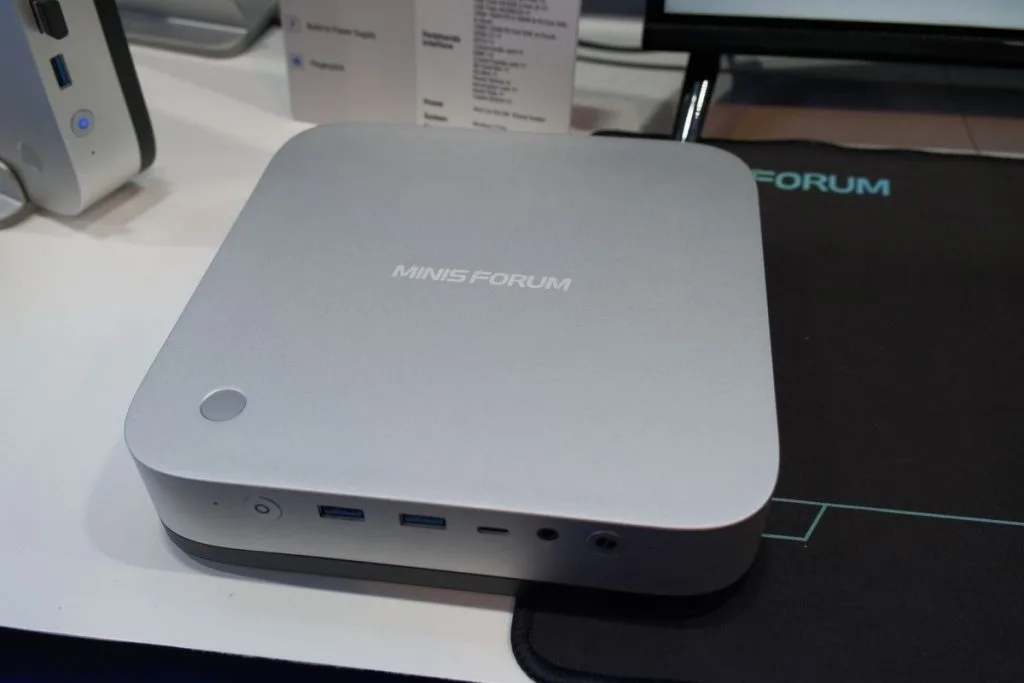
The Minisforum AI X1 Pro takes inspiration from Apple's Mac Mini design but adds its own distinct character.
It's a bit taller than the Mac Mini, with a larger bottom section, creating a substantial and premium-feeling device.
Despite its compact dimensions (195 × 195 × 47.5mm), this mini PC has a solid heft to it at 1.5kg, suggesting quality construction.
Unlike many mini PCs that use plastic, the AI X1 Pro features a predominantly metal construction with a black plastic base.
The device can be positioned horizontally on a desk or placed vertically using the included high-quality stand.
Minisforum also includes a VESA mounting bracket, allowing you to attach the mini PC to the back of a compatible monitor for a cleaner setup.
One of the most notable design features is the integrated power supply — a rarity in the mini PC world.
This eliminates the need for an external power brick, resulting in a cleaner setup with just a standard figure-8 power cable.
This design choice does increase the unit's size compared to other mini PCs, but the trade-off is worth it for many users who prefer a cleaner desk.
Front Panel and Top Features
The front panel of the AI X1 Pro is well-equipped with essential ports and features:
- Power button
- Two USB 3.2 Gen 2 Type-A ports
- One USB4 port (supports 40Gbps and 15W power delivery)
- 3.5mm audio combo jack
- Dedicated Copilot button
On the top of the unit, you'll find a fingerprint sensor that works with Windows Hello for quick and secure logins.
This is particularly convenient when the device is placed horizontally, though less accessible if mounted behind a monitor or positioned vertically.
Rear and Side Connectivity
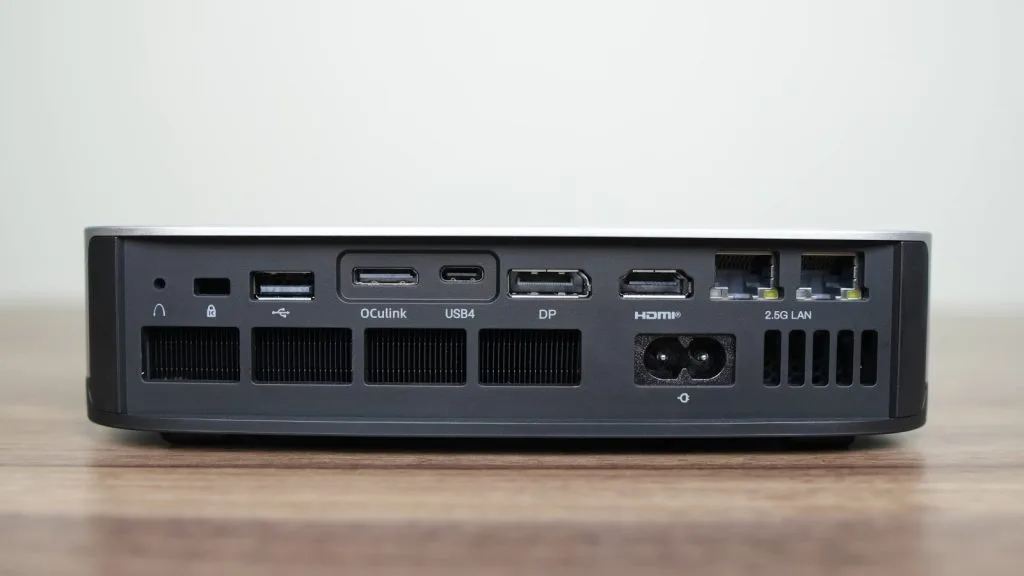
The right side of the unit houses a full-sized SD card reader, which is particularly useful for content creators who frequently transfer photos or videos from cameras.
The rear panel is where most of the connectivity options are located:
- Reset button
- Kensington lock connector
- USB 2.0 Type-A port
- OCuLink port (PCIe 4.0 × 4)
- USB4 port (supports 100W power input and 15W output)
- DisplayPort 2.0 (supports 8K@60Hz or 4K@120Hz)
- HDMI 2.1 (supports 8K@60Hz or 4K@120Hz)
- Dual 2.5 Gigabit Ethernet ports
- Power input connector
Internal Hardware and Specifications
The Powerful AMD Ryzen AI 9 HX 370
At the heart of the AI X1 Pro is AMD's Ryzen AI 9 HX 370 processor, also known as "Strix Point."
This 12-core, 24-thread CPU features 8 efficiency cores and 4 performance cores, with a base clock of 2.0GHz and the ability to boost up to 5.1GHz when needed.
The processor is built on AMD's Zen 5 architecture, which delivers excellent performance per watt.
The HX 370 is specifically designed with AI capabilities in mind, featuring a dedicated Neural Processing Unit (NPU) that contributes to its impressive 80 TOPS (Trillions of Operations Per Second) rating, with the NPU alone responsible for 50 TOPS.
This qualifies the AI X1 Pro as a Microsoft Copilot+ PC, which requires at least 40 TOPS to meet the standard.
Integrated Graphics: Radeon 890M
The integrated Radeon 890M graphics are based on AMD's RDNA 3.5 architecture and feature 16 compute units that can clock up to 2900MHz.
While not as powerful as a dedicated GPU, the 890M represents a significant step up from previous integrated solutions and can handle a surprising range of modern games at 1080p with medium to high settings.
One important note is that the AI X1 Pro uses user-replaceable DDR5 SODIMM memory running at 5600MHz, unlike some competing HX 370 mini PCs that use soldered memory running at higher frequencies (7500MHz or 8000MHz).
This difference does impact the graphics performance, as the Radeon 890M relies on system memory.
In gaming benchmarks, this translates to about 10-30% lower framerates compared to systems with faster memory, depending on the game.
Memory and Storage Options
The AI X1 Pro features two DDR5 SODIMM slots that support up to 128GB of total memory.
The unit typically ships with configurations of 32GB or 64GB, using Crucial DDR5-5600 modules.
Having upgradeable memory is a significant advantage for users who may need to expand their system's capabilities in the future.
For storage, the AI X1 Pro really stands out with three M.2 2280 NVMe SSD slots.
Two of these slots operate at PCIe 4.0 × 4 speeds (offering up to 8GB/s theoretical bandwidth), while the third operates at PCIe 4.0 × 1 speeds (suitable for less speed-critical storage).
This allows for a maximum storage capacity of 12TB if all slots are populated with 4TB drives.
The system typically ships with a 1TB Kingston Gen4 NVMe SSD preinstalled, which performs adequately but not exceptionally, comparable to a good Gen3 drive in benchmarks.
Networking and Wireless
The AI X1 Pro features an impressive networking setup with dual 2.5 Gigabit Ethernet ports, perfect for home lab setups or network-intensive applications.
For wireless connectivity, it includes a MediaTek Wi-Fi 7 chip with support for the 6GHz band and 320MHz channels, providing extremely fast wireless speeds when paired with a compatible router.
Bluetooth 5.4 is also included, offering reliable peripheral connections with good range and stability in testing.
Performance Benchmarks
The AI X1 Pro delivers impressive benchmark results that place it at the top of the mini PC rankings for 2025.
Let's examine how it performs across various scenarios.
CPU Performance
In Cinebench R24, the AI X1 Pro scored around 1,224-1,231 points in the multi-core test, outperforming many desktop CPUs including some older Threadripper models.
This is particularly impressive considering the compact form factor and thermal constraints.
In single-core tests, the system scored approximately 119 points, beating the Apple M1 Max and M1 Ultra chips.
This excellent single-core performance translates to snappy responsiveness in everyday applications.
Geekbench 6 results confirm the exceptional CPU performance, with scores of approximately:
- Single-core: 2,920-2,994
- Multi-core: 15,287-15,726
These scores place the AI X1 Pro at the top of the 2025 mini PC performance chart, outperforming even some high-end desktop systems from previous generations.
Graphics Performance
The integrated Radeon 890M graphics deliver solid performance for an iGPU, though as mentioned earlier, the 5600MHz DDR5 SODIMM memory does limit its potential compared to systems with faster memory.
In 3DMark benchmarks, the AI X1 Pro achieved:
- Time Spy: ~3,197-3,500
- Fire Strike: ~8,122
- Steel Nomad: ~2,991
It's worth noting that systems with the same HX 370 processor but faster 7500MHz or 8000MHz memory can score up to 40% higher in graphics benchmarks.
However, those systems typically lack upgradeable memory, so there's a clear trade-off here.
Storage Performance
The included Kingston Gen4 NVMe SSD performs adequately but not exceptionally in benchmarks.
For most users, it provides sufficient speed, but professionals working with large files might want to consider upgrading to a faster drive.
External storage performance is excellent, with the USB4 ports capable of delivering over 3GB/s read speeds when tested with high-performance external SSDs.
AI Capabilities
The AI X1 Pro, with its claimed 80 TOPS of AI performance (50 TOPS from the NPU alone), should theoretically excel at AI workloads.
However, real-world testing reveals that software support for AMD's NPU is still developing.
In Geekbench AI benchmarks, the system showed excellent CPU-based AI performance but had limited NPU utilization.
Microsoft's Copilot features generally run in the cloud rather than leveraging the local NPU, which somewhat undermines the "AI PC" marketing.
Real-World Performance
Everyday Computing
For everyday tasks like web browsing, office applications, video streaming, and multitasking, the AI X1 Pro is exceptionally capable.
The system boots quickly, applications launch instantly, and even with dozens of browser tabs open alongside multiple applications, the system remains responsive and fluid.
The fingerprint sensor provides quick and reliable Windows Hello authentication, and the overall Windows 11 experience is smooth and polished.
Content Creation Performance
The AI X1 Pro handles content creation tasks impressively well for a mini PC.
In 4K video editing tests, the system was able to handle complex timelines in applications like Adobe Premiere Pro without dropping frames or exhibiting lag.
For photo editing in applications like Photoshop or Lightroom, the system performs excellently, with smooth filters, adjustments, and layer operations even on large files.
The system also performed well in encoding tests, though AMD's media engine isn't quite as efficient as Intel's Quick Sync for certain video encoding workloads.
Gaming Performance
Gaming performance on the AI X1 Pro is surprisingly good for a system with integrated graphics.
At 1080p resolution with appropriate settings, many modern titles are playable with acceptable framerates.
Here's how the system performed in various games at 1080p:
More demanding titles like Cyberpunk 2077 require reduced settings and resolution scaling technologies like FSR to maintain playable framerates.
Games with ray tracing tend to struggle significantly, even with frame generation technologies enabled.
The OCuLink port allows for connecting an external GPU, which can dramatically improve gaming performance.

In tests with an RTX 4070 Super connected via OCuLink, performance scaled up significantly, allowing for comfortable 1440p or even 4K gaming in many titles.
AI Workloads
The AI X1 Pro can handle entry to mid-tier AI workloads, including:
- Basic image generation
- Real-time video analysis
- Text extraction from video
- AI-assisted creative workflows
It's worth noting that Windows' Copilot feature, despite having a dedicated button on the front of the device, primarily relies on cloud processing rather than the local NPU.
Thermal Performance and Noise
The AI X1 Pro features a dual-fan cooling system that does an excellent job of managing heat, even under sustained heavy workloads.
During testing, the CPU temperatures peaked at around 69°C under full load running Cinebench R24, and gaming temperatures typically stayed around 60°C.
The cooling system allows the CPU to maintain its performance without thermal throttling, even during extended stress tests.
This is impressive for a compact system with such a powerful processor.
Noise levels are surprisingly low for a mini PC with this level of performance.
Even in performance mode under heavy load, the fans remain relatively quiet.
In regular use, the system is almost silent.
This makes the AI X1 Pro suitable for quiet environments like living rooms or offices where noise might be a concern.
Power Consumption
Power consumption for the AI X1 Pro is reasonable given its performance:
- Idle: 9-10 watts
- Light usage: 15-20 watts
- Gaming: 60-70 watts
- Maximum load: 80-86 watts
The 135W internal power supply provides plenty of headroom even under full load, and the system can also be powered via USB-C (with a compatible 100W power delivery source) through the rear USB4 port.
Upgradeability and Expansion
One of the strongest aspects of the AI X1 Pro is its upgradeability.
Unlike many mini PCs with soldered components, this system offers several options for future expansion.
Accessing the Internals
Opening the AI X1 Pro requires removing five screws on the bottom of the unit (four visible and one hidden under a rubber pad) and then disconnecting several cables inside before removing the cooling plate.
It's not the easiest mini PC to open, but it's manageable with basic tools and care.
Memory and Storage Upgrades
The two DDR5 SODIMM slots support up to 128GB of memory, allowing for significant future upgrades.
The default configuration usually includes two 32GB (64GB total) Crucial DDR5-5600 modules.
With three M.2 NVMe slots available, storage expansion is straightforward.
Two of the slots support PCIe 4.0 × 4 speeds, while the third slot operates at PCIe 4.0 × 1 speeds.
The system includes a spare M.2 thermal pad and heatsink for additional drive installations.
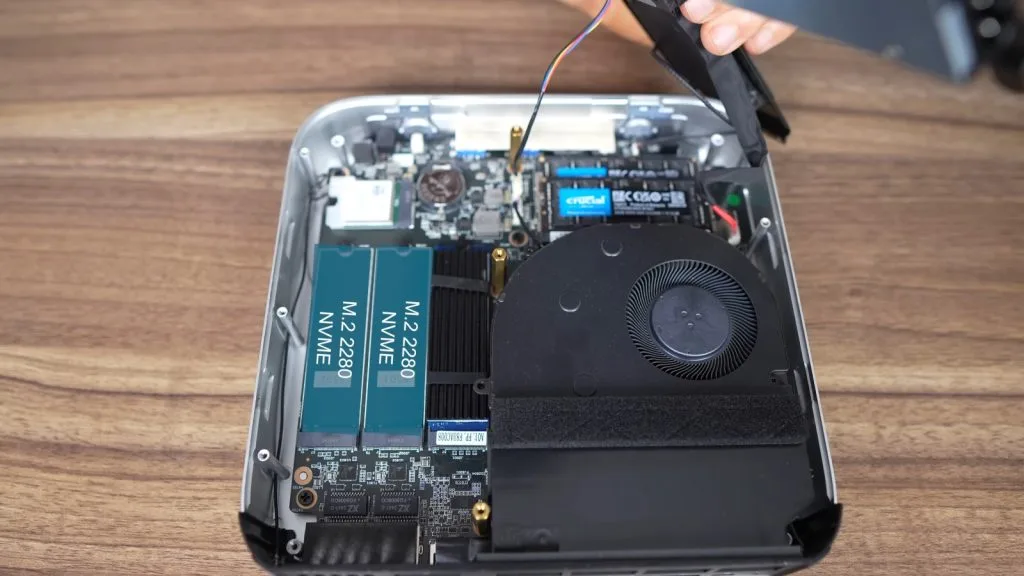
External Expansion via OCuLink
The OCuLink port (PCIe 4.0 × 4) offers significant expansion possibilities.
It can be used to connect:
- External graphics cards through an OCuLink to PCIe adapter
- External storage arrays
- Expansion cards for additional functionality
This provides flexibility for users who might need additional graphics power for gaming or professional workloads in the future without needing to replace the entire system.
BIOS and Software
The AI X1 Pro ships with a visual BIOS that's easy to navigate using a mouse and keyboard.
The BIOS offers several configurable options, including:
- Power limit settings (auto, 15W, 20W, 28W, 45W)
- VRAM allocation (configurable up to 48GB)
- Fan curve adjustments
- Boot device selection
The system comes with Windows 11 Pro pre-installed, with minimal bloatware.
A malware and rootkit scan showed the system was clean out of the box.
Ubuntu Linux was also tested and worked without issues, suggesting good compatibility with alternative operating systems.
Comparisons with Other Mini PCs
The AI X1 Pro competes with several other high-performance mini PCs in the market.
Here's how it stacks up against some notable alternatives:
AI X1 Pro vs. Beelink SER9
The Beelink SER9 also features the Ryzen AI 9 HX 370 but uses soldered LPDDR5X-7500 memory.
This results in better graphics performance (15-30% higher in games) but lacks the upgradeability of the AI X1 Pro.
The SER9 also doesn't include features like OCuLink, fingerprint sensor, or a third M.2 slot.
AI X1 Pro vs. GMKtec EVO X1
The GMKtec EVO X1 uses the same processor with faster LPDDR5X-7500 memory, resulting in better graphics performance.
However, it lacks the extensive upgradeability, OCuLink port, and internal power supply of the AI X1 Pro.
AI X1 Pro vs. Minisforum MS-01
The Minisforum MS-01 features an Intel Core i9-13900H processor and includes a PCIe 4.0 x16 slot for internal GPU upgrades, along with 10G SFP+ networking.
It offers greater expandability for GPU-intensive workloads but has higher power consumption and different thermal characteristics compared to the AMD-based AI X1 Pro.
Pros and Cons
Pros
- Excellent CPU performance with the 12-core, 24-thread Ryzen AI 9 HX 370
- Built-in power supply eliminates external brick
- Three M.2 NVMe slots for extensive storage options
- Upgradeable memory (up to 128GB)
- OCuLink port for external GPU or expansion
- Generous port selection including dual USB4
- Good thermal performance with relatively quiet operation
- Fingerprint reader for Windows Hello authentication
- Built-in SD card reader
- Wi-Fi 7 and dual 2.5G Ethernet
Cons
- DDR5-5600 SODIMM memory limits GPU performance compared to systems with faster LPDDR5X
- Larger physical size compared to some competing mini PCs
- Limited NPU software support for AI capabilities
- No 10G networking option
- Not the easiest mini PC to open for upgrades
- Front panel finish prone to scratches
- The Kingston SSD included could be faster for a premium device
Who Should Buy the AI X1 Pro?
The Minisforum AI X1 Pro is an excellent choice for several types of users:
- Content creators who need a compact yet powerful system for video editing, photo processing, and other creative workloads
- Home lab enthusiasts who want a powerful system for running virtual machines or servers while maintaining upgradeability
- Casual gamers who want a compact system that can handle most modern games at 1080p and have the option to add an external GPU later
- Professionals who need a powerful workstation in a small form factor with the ability to drive multiple displays
- Users who value upgradeability and want a system that can grow with their needs over time
The AI X1 Pro may not be ideal for:
- Dedicated gamers who prioritize maximum gaming performance (unless paired with an external GPU)
- Users who need 10G networking without additional adapters
- Those seeking the absolute smallest mini PC possible
Pricing and Availability
The Minisforum AI X1 Pro is available in several configurations:
- Barebones (no RAM, no SSD, no OS): $879
- 32GB RAM, 1TB SSD, Windows 11 Pro: $1,129
- 64GB RAM, 1TB SSD, Windows 11 Pro: $1,229
- 96GB RAM, 2TB SSD, Windows 11 Pro: $1,369
These prices position the AI X1 Pro as a premium mini PC, but the performance, features, and upgradeability justify the cost for users who need a powerful and flexible compact system.
Frequently Asked Questions (FAQ)
How does the Minisforum AI X1 Pro compare to a PlayStation 5 for gaming?
The AI X1 Pro's integrated Radeon 890M graphics are significantly less powerful than the PlayStation 5's GPU.
While the X1 Pro can run many modern games at 1080p with reduced settings, it offers approximately 30-40% of a PS5's graphics performance.
However, connecting an external GPU via OCuLink can exceed PS5 performance.
Can the Minisforum AI X1 Pro run Linux?
Yes, the AI X1 Pro can run Linux distributions like Ubuntu 24.04 without issues.
However, some specialized features like the NPU may have limited driver support in Linux environments.
How much of a performance hit does the 5600MHz RAM cause compared to systems with 7500MHz memory?
For CPU-intensive tasks, the difference is minimal (less than 5%).
For graphics and gaming workloads that depend heavily on memory bandwidth, the performance difference can range from 10% to 30%, depending on the specific game or application.
What kind of external GPU can I connect to the AI X1 Pro?
The OCuLink port supports PCIe 4.0 × 4 bandwidth, allowing you to connect virtually any modern GPU through an OCuLink to PCIe adapter with an appropriate power supply.
GPUs like the RTX 4070, RX 7700 XT, or similar cards work well with this setup.
Does the AI X1 Pro support Wi-Fi 7?
Yes, the AI X1 Pro includes a MediaTek Wi-Fi 7 module that supports the 6GHz band and 320MHz channels for extremely fast wireless speeds when paired with a compatible Wi-Fi 7 router.
How many displays can the AI X1 Pro support?
The AI X1 Pro can support up to four displays simultaneously using the HDMI, DisplayPort, and both USB4 ports.
Each port supports 4K resolution at 60Hz or higher.
What's the maximum RAM capacity of the AI X1 Pro?
The AI X1 Pro supports up to 128GB of DDR5 SODIMM memory across its two memory slots (2 × 48GB configuration).
Can the AI X1 Pro run virtual machines effectively?
Yes, with 12 cores, 24 threads, and support for up to 128GB of RAM, the AI X1 Pro is excellent for running virtual machines.
It includes full virtualization support through AMD-V.
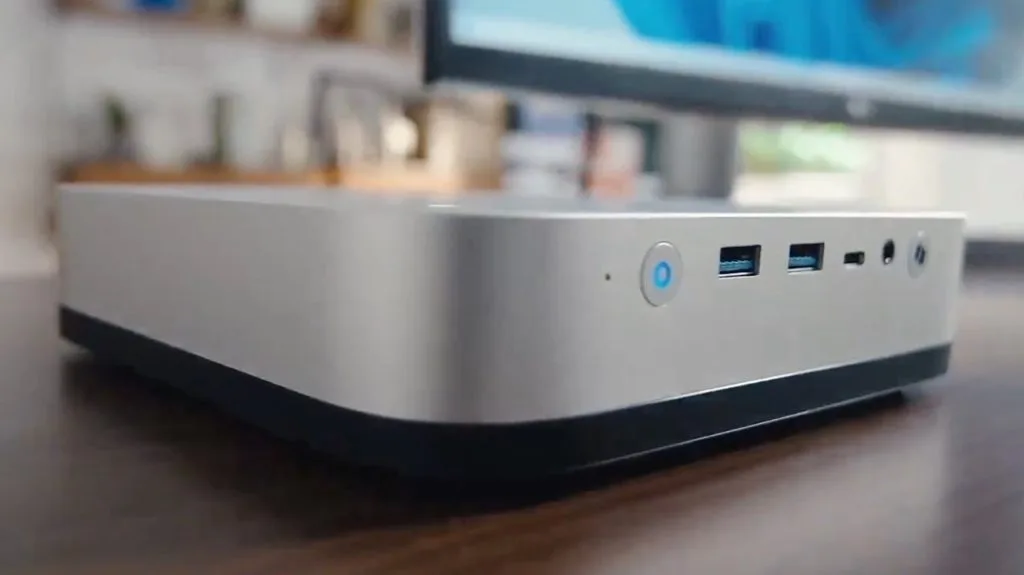
Does the AI X1 Pro support PCIe 5.0?
No, the AI X1 Pro's storage and OCuLink ports support PCIe 4.0 specifications, not PCIe 5.0.
How loud is the fan noise during intensive tasks?
The AI X1 Pro maintains relatively low noise levels even under load.
In performance mode with intensive tasks, the fans are audible but not distracting, comparable to a quiet laptop under load.
Can I power the AI X1 Pro through USB-C?
Yes, the rear USB4 port supports USB Power Delivery input up to 100W, allowing you to power the system through a compatible USB-C power adapter or monitor.
Does the AI X1 Pro support Windows Hello?
Yes, the built-in fingerprint sensor on the top of the unit fully supports Windows Hello for secure and convenient login.
What's the significance of the Copilot button?
The Copilot button on the front of the unit provides one-touch access to Microsoft's Copilot AI assistant in Windows 11.
However, this button can be remapped to other functions using utilities like PowerToys if preferred.
Is the AI X1 Pro good for running local LLMs (Large Language Models)?
The AI X1 Pro can run smaller LLMs, but its performance for larger models is limited without an external GPU.
The system's ability to support up to 128GB of RAM is beneficial for running larger models, though memory speed impacts performance.
Conclusion
The Minisforum AI X1 Pro represents an impressive balance of performance, upgradeability, and features in a compact form factor.
Its powerful AMD Ryzen AI 9 HX 370 processor delivers outstanding CPU performance, while the integrated Radeon 890M graphics provide respectable gaming capabilities for a system of this size.
Where the AI X1 Pro truly shines is in its expandability and flexibility.
With three M.2 NVMe slots, upgradeable memory supporting up to 128GB, and the OCuLink port for external expansion, this mini PC offers future-proofing that many competing systems lack.
The built-in power supply is another significant advantage, eliminating the need for an external brick.
While the use of 5600MHz SODIMM memory does impact graphics performance compared to systems with faster LPDDR5X memory, the trade-off for upgradeability will be worthwhile for many users.
Similarly, the current limited software support for the NPU's AI capabilities may improve over time as developers embrace these new technologies.
Overall, the AI X1 Pro stands as one of the most capable and versatile mini PCs available in 2025.
It's an excellent choice for users who need significant computing power in a compact form factor while maintaining options for future upgrades and expansion.
Whether for content creation, productivity, casual gaming, or as a powerful home server, the AI X1 Pro delivers exceptional performance that justifies its premium price point.


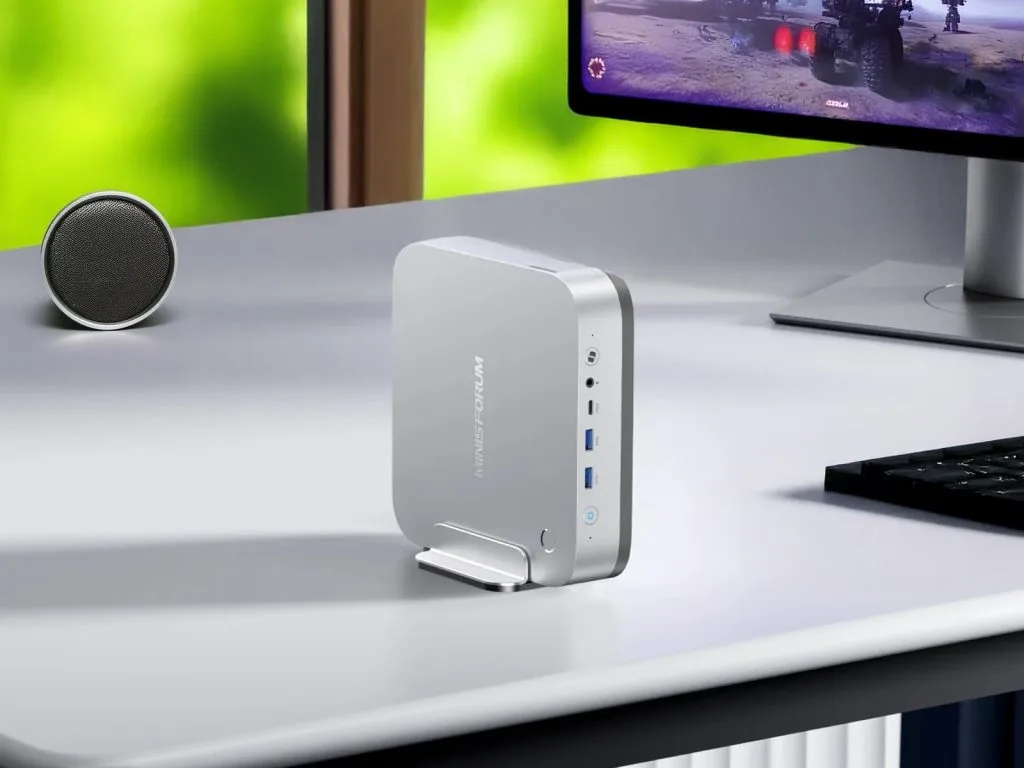

I have the Minisforum AI X1 Pro, and I’m very pleased with it. Since I purchased it, I noticed that the specifications on the website had changed and the system can support up to 128 GB of RAM. I confirmed this with Minisforum customer support, and I have been running my AI X1 Pro with 128 GB of DDR5 5600 RAM for about 10 days now with no issues.
Hey Ron, that’s awesome to hear! I’ve updated the post to reflect the 128 GB support. Thanks for letting me know and enjoy your AI X1 Pro!